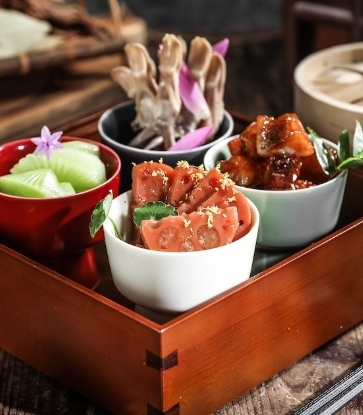Shanghaiese (people) have always been meticulous about pastries and snacks, which are an integral part of their childhood memories. Enjoying the specific snacks has also become a unique food custom in Jiangsu.
Chinese festive foods are amazing - rice balls for the Chinese New Year, green dumplings (Qingtuan) for Ching Ming Festival and flower cake (Chongyang cake) for Chongyang Festival.
The Mid-Autumn Festival is another peak for eating, with sweet-scented osmanthus cake, sweet fermented-rice, sugar taro, lotus root stuffed with glutinous rice. But mooncakes always take the stage. Different from Cantonese mooncakes, Suzhou mooncakes are smaller in size, wrapped in crispy pastry moulded by the hands of skilful dim sum chefs rather than wooden models. Local Shanghaiese prefer the savoury “Fresh Meat Mooncakes”, which encompass the balance of brittleness, salty tastes and aroma in just one bite. Yet, the sweet "Bean Paste Mooncake", "Black Beans Mooncake" and “Date Paste Mooncake” are also highly appreciated by a few generations.

The Mid-autumn season is also the busiest time in the year for the Michelin-starred Zhejiang restaurant "Zhejiang Heen". While the restaurant manager takes phone-in orders, chef Pan Jiulong and the dim sum supervisor ensure the mooncakes are delivered on schedule. “Mooncakes are usually gifts. We have to keep our promise and make sure they are delivered on time. At the most, we can produce 200 boxes per day, which is 1,600 pieces.” Chef Pan recalled that when the restaurant opened eleven years ago, their capacity was only 1,000 boxes during the peak season. The restaurant then became more famous and the team was getting more and more skilful. Today, they can produce 4,000 boxes for the whole season, but mass production in a factory is not an option for the chef. “We might make less profit, but the mooncakes will lose their vitality if they are mass-produced.”
READ MORE:Savour Mooncakes at Hong Kong Tablet Hotels’ MICHELIN Restaurants




Juggling between manpower shortage and the guests’ expectations, chef Pan's approach is to shape the puff pastry in a quicker manner by first rolling the whole pastry and then cutting it into small rolls, as well as using semi-prepared bean paste fillings. Attending to meticulous details, he makes the puff pastry with lard. “This is the way to bring out the aroma and crispiness”. The bean paste needs to be mixed with some oil and kept stir-frying till it becomes shiny. “’Finest red bean pastes with aromatic lard” is the golden rule for mooncake in Shanghaiese’s view.” Lard/Oil instead of salted egg is used an essential ingredient to bring out the fragrance of traditional Suzhou mooncakes. Uncovering the secret of making pleasantly sweet red bean mooncakes, he said, “I blended in a bit sugar osmanthus in the sweet fillings!" The flower blooming in early autumn in the south of the Yangtze River, with its name sounds like “wealth and prosperity” carries people’s wishes for fortune. Chef Pan always marks a red dot on the red bean mooncake with a small wooden stick to send festive blessings to the recipients.
(Left:The layers of the puff pastry is and fragile. )


The ”red marks” on the mooncakes come with a practical use: distinguish the red bean mooncakes from the fresh meat ones. The name “fresh meat” indicating the essence of the mooncakes means only “fresh” pork can be used. “We have to use fresh “red meat” (pork hind leg),” he explains that red meat with a moderate proportion, “about 60%” of lean meat is the best choice. By adding appropriate amount of water, the grilled pork will be very juicy. He even blends ginger water into the minced meat to create a long lasting and intriguing taste.



Nowadays, only a few Huaiyang restaurants in Hong Kong and Macau are eager to handmake Suzhou mooncakes by themselves, “Zeihiang Heen” is one of them. “I hope people from our hometown and those from Hong Kong can enjoy the company of delicacies, tea drinking, as well as chitchatting in the fast-paced life.”
Let’s cherish the delightful mooncakes and enrich our lives with beautiful memories.
(On the right:Chef Poon Gau Lung from Zhejiang Heen.)
READ MORE: Dragon Boat Festival: Shanghainese vs Cantonese Rice Dumplings
Photos taken by Moo Hung.





















